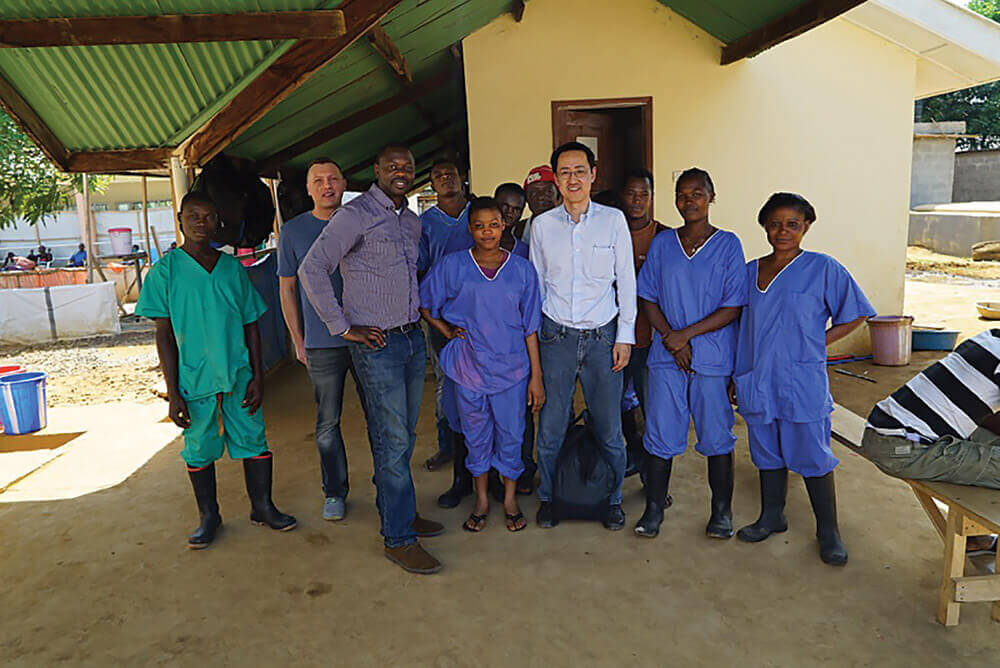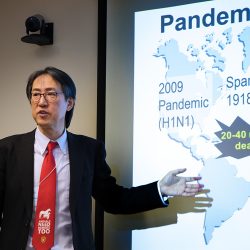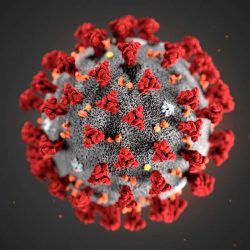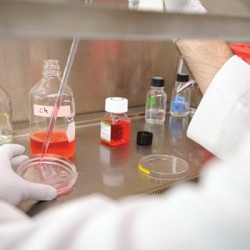
Kawaoka told legislators at the state capitol in April that his Ebola vaccine is about two years away from clinical trials in humans. Photo: Jeff Miller.
All science has a backstory, and the development of a safe, effective, whole-virus Ebola vaccine in the lab of UW–Madison virologist Yoshihiro Kawaoka is no exception.
The new vaccine, which was described in a report in the journal Science in March, has advantages over other experimental vaccines because, as a whole-virus vaccine, all of the viral proteins and genomic materials needed to prime the host immune system and confer immunity are present. Other vaccines use bits and pieces of the Ebola virus to elicit an immune response.
The Wisconsin vaccine has been proven in monkeys — a critical hurdle — but is still a long way from helping stem the tide of contagion in West Africa, which so far has claimed the lives of at least 10,000 people. But if deemed successful and safe in a human trial, the vaccine could be a game-changer, not only in its ability to help beat back a horrific disease, but also in how scientists devise new countermeasures to other viruses of medical importance.
Working with UW scientist Peter Halfmann, Kawaoka made the new vaccine using a technology that the two first devised in 2008. The technology, known as Delta VP30, renders the Ebola virus impotent to replicate in a host cell by excising just one of its eight genes. The gene produces a protein, VP30, that the virus needs to grow in a host cell. By engineering the same gene into monkey kidney cells, researchers can work safely with the altered virus under conditions less stringent than those required for working with unaltered live Ebola.
For vaccine development, that’s important. Kawaoka explains that making a vaccine, even for a limited human trial, requires producing a lot of virus, something that can’t be done in the Biosafety Level (BSL) 4 facilities where research with live Ebola is typically confined. What’s more, vaccines are required to be made under what is known as Good Manufacturing Practice (GMP), a system designed to ensure pharmaceuticals are produced consistently under controlled conditions at high quality. There are no BSL 4 facilities with a GMP system in place, Kawaoka says.

In Sierra Leone, where more than 3,800 people have died from the Ebola virus, UW virologist Yoshihiro Kawaoka is analyzing blood samples from patients, including those who have survived the virus. “Not everyone dies,” says Kawaoka, shown here at center with staff members at an Ebola treatment facility. More than 8,500 cases of Ebola have been confirmed in the West African country, and the goal is to combat the virus at its point of origin by identifying proteins and genes that can modify infections. The university’s research team includes Alhaji N’jai (at left center), a pathological sciences research fellow who is a native of Sierra Leone, and Peter Halfmann (at left in back row), a research scientist who helped develop the whole-virus vaccine in Kawaoka’s lab. Courtesy of Yoshihiro Kawaoka.
“It would be almost impossible to make this vaccine without the Delta VP30 technology,” he says. “The Delta VP30 virus can be handled under BSL 3 conditions, and there are GMP-BSL 3 facilities. You need that to produce a whole-virus vaccine for a clinical trial.”
The strategy to make viruses “replication incompetent” has been extended to other diseases. “We use the same concept for influenza viruses,” which makes them easier to study and use, Kawaoka notes, referencing a flu vaccine developed by his company, FluGen.
The challenge with the technology is creating stable cell cultures that express the protein the altered viruses need, yet are incapable of making.
Kawaoka’s method shows that taming a feared pathogen can make it easier to study, help reduce costs, and, critically, enhance our ability to produce effective vaccines for terrible diseases.
Published in the Summer 2015 issue



Comments
No comments posted yet.